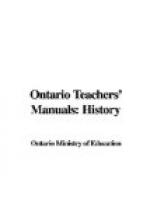The teacher must also know children. For the understanding of history, pupils are dependent on their previous knowledge of life and its interests. They must be led by timely suggestions or questions to see the connection between their own knowledge of life and the experiences of the actors in history. Without this connection, the facts of history remain meaningless.
To present history to the pupils in an interesting way, the oral method is the best. It is not necessary for the teacher to have a special gift for narration; any one who is really interested in the story to be told is able to tell it well enough to hold the attention of the class. In narration, mere fluency is not the chief requisite; it is more important that the pupils should feel the teacher’s interest in the topic. The narration must also be confined to the facts and details that count; the teacher needs to know what to omit as well as what to narrate. If the matter has been well thought out and clearly arranged in topics with due regard to the relation of cause and effect, the telling of the story will be an easier matter, and the pupils will be trained also in a clear and logical way of treating history. The oral method should be supported by the free use of devices for making the story real. (See p. 34.) While it is quite true that certain important topics are to be thoroughly mastered as centres of connection for the less important facts, yet it must be insisted on that a more important aim of the teacher is to arouse and stimulate an interest in history so that the pupil’s study of it may continue after the close of his school-days. No mastery of facts through memorization alone will counterbalance the lack of interest in, and liking for, the subject.
CHAPTER V
ILLUSTRATIVE LESSONS
The following lessons are to be considered as suggestive rather than directive, as illustrating how the principles of teaching may be applied in a particular subject. Definite knowledge of child-nature and of children’s experiences, of the materials to be used, and of the purpose to be accomplished in teaching a subject, determines, in the main, the choice of method. This statement is especially true of history, for, unless it is steadily borne in mind, the temptation is very great to make the teaching of this subject consist in mere memorizing of events and dates.




